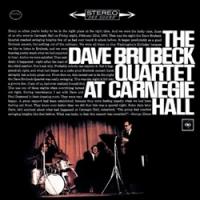"The Dave Brubeck Quartet At Carnegie Hall" Issued on Double 180g Vinyl
It was also the world's most popular and well-known jazz ensemble, having toured the world for the State Department and released numerous big selling albums such as Time Out, which sold well in excess of a million copies.
Brubeck had been on the cover of Time Magazine in 1954, which he found somewhat embarrassing since he was there but Duke Ellington was not. Brubeck's discography was already extensive by the time this live recording was issued on vinyl in 1963.
No wonder the concert sold out despite an ongoing newspaper strike that almost caused the promoters to cancel it.
The full house was treated to an exceptionally fine concert, one Brubeck thought was among the group's best, according to the liner notes written by New York Herald Tribune jazz commentator George T. Simon, who sat with Brubeck listening to tape playback.
These guys had played together for so long that a casual listen reveals nothing musically startling or exceptional, probably because they make it sound so easy. Brubeck's comments put that idea to rest, though you can just listen and enjoy minus the genuinely fascinating analysis.
Brubeck's jazz snob detractors are many but why let them spoil the pleasures to be found here? The solos by Morello, Desmond and Wright and more importantly the overall quartet flow make this live set a breezy, musical pleasure despite a bit too much back catalog advertising by Brubeck between tunes. Brubeck sounds as if he patterned his patter after the MJQ's John Lewis and like the MJQ, despite the outward appearance of set performances, Brubeck's quartet was constantly improvising
Many people dismissive of Brubeck's talents forget that he suffered considerable nerve damage early in his career from a surfing accident that caused him to switch from single note complexity to block chording, though here he does produce some dazzling single note runs. Listen to his first solo on "Bossa Nova U.S.A" (a hit single for the group, here extended to allow all to improvise on the tune).
Not to sound like a jazz snob, but Desmond's, Morello's and Wright's solos are consistently more interesting to listen to than are Brubeck's who does his best work comping and supporting the others. By comparison, while their solos flow subtly, Brubeck's often sound clunky or like Ellington playing with a ball peen hammer. Listen to his solo on "For All We Know" and tell me if you can disagree, though the notes themselves are interesting.
The twelve song set includes standards and crowd pleasers like "It's a Raggy Waltz", "Blue Rondo A La Turk" and the obligatory encore "Take Five." The note from producer Teo Macero states that there's not a single musical edit on the records, though the song order was rearranged somewhat to fit the LP format and applause was shortened for better fit and flow.
Some live recordings at Carnegie Hall treat the audience applause as seriously as the music in order to help create the "you are there" feel. It's not critical but it can add to the illusion. That's not the case here, where the applause sounds AM radio boxy, so don't expect The Weavers Reunion.... type verisimilitude!
More importantly, the instruments themselves are reasonably well recorded and placed within a suitably reverberant Carnegie Hall environment, though the perspective is close-up, which doesn't always match well with the amount of hall sound behind and around the instruments..
Brubeck is placed stage left (right channel) in fine focus, Morello on the opposite side, with Wright and Desmond center stage, Desmond well out in front, though that's not quite the stage layout based on the gatefold jacket photos. However, for the sake of a recording, that layout makes sense (the photos show Brubeck center stage and Morello stage left). Overall, this is a fairly well recorded Carnegie Hall set, but don't expect "you are there" magical sonics. Brubeck's piano is very well-recorded, however, and free of major boxy colorations.
Comparing this Speakers Corner reissue to an original black "360 Sound" 1A pressing favors the original, of course, which is more open and extended on top and allows the reverberant field to more fully flow and express itself. The Speakers Corner reissue is somewhat darker and veiled by comparison but without the original to compare it to, it's decent and very "analogue-y" sounding. And of course the Pallas pressing quality is superb. My used original gets "crunchy" in spots.
P.S.: The very first live concert I ever attended was The Dave Brubeck Quartet at Town Hall, NYC, probably a year before this was recorded. I felt like an adult for the first time in my life, though I soon regressed to infantile adolescent behavior, where I've happily remained ever since.



